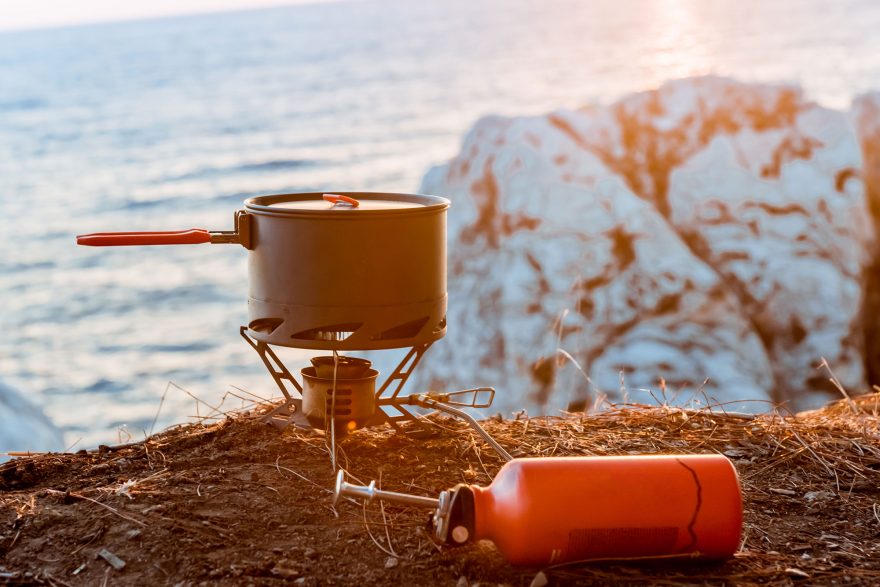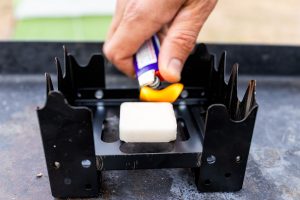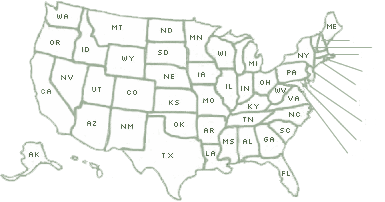
Finding the best portable camp stove for your overnight wilderness trip can mean the difference because a fun or a dud outing
If you’re someone who loves to come back to a hot meal and a warm drink after a day exploring the wilderness, you should know how to choose the best portable camp stove for your excursion. No longer do you need to spend time collecting and carrying wood and then hoping the fire will light and stay. Stoves for backpacking allow you to reduce cooking times and improve portability.
Camping stoves come in a variety of forms, suited to different uses. Are you cooking for yourself or for a group of people? Do you need something lightweight for solo hikes or are you taking it in the car at weekends?
In this guide, I’ll cover:
- Canister stoves
- Liquid fuel stoves
- Alternative fuel stoves
- Pros and cons of each

Canister Stoves
Canister stoves are simple, lightweight, and reliable.
The pressurized gas canister is normally a mix of propane and either butane or isobutane and the large majority are screw-on canisters. Aside from being small and lightweight, they also typically deliver efficient boil times.
Canister stoves (like MSR’s Ultralight PocketRocket 2) are probably the most popular choice among backpackers because of their ease of use and portability. To get it going, you simply have to screw the canister onto the stove, open the valve, and then light the burner.
If you’re looking to make the most of the space you have and improve efficiency, this is a solid choice.
Pros
- Lightweight and compact
- Fast boil times
- Good flame and temperature control
- Low on mess
- Easy to light and no priming is necessary
Cons
- Some models have short arms
- Canisters can depressurize in cold temperatures and produce a weaker flame
- Fuel is more expensive than other types
- Hard to know how much gas is left in the canister
- Difficult to refill
Integrated Canister vs. Remote Canister Stoves
If you decide to go for a canister stove, you also need to decide between an integrated canister system or a remote canister system.
As the name suggests, an integrated canister stove is an all-in-one stove that includes a burner, heat exchanger and a pot. They are generally taller and usually made to boil water quickly rather than cook and simmer food.
Remote, or non-integrated, canister stoves are typically much more versatile, featuring a stove that sits on its own base attached to a hose that connects to the canister. They’re less bulky, have a lower profile, and you get better flame control. The downside is that they’re more exposed and can be the victim to poor weather.
Liquid Fuel Stoves
Liquid fuel stoves (the MSR WhisperLite or BRS Outdoor are examples) are an excellent choice for longer trips since they stoves come with a refillable fuel bottle.
Although maybe not as popular among backpackers, these stoves tend to work better in colder temperatures, running on white gas which burns clean and hot and they are generally more cost-effective than canister stoves.
Some liquid stoves can run on multiple fuel sources (multi-fuel stoves), like unleaded auto gasoline, kerosene, jet fuel or diesel. This makes it popular among people traveling overseas where there are limited choices of fuel you can get.
Pros
- Fuel is easy to find
- Less waste since they’re refillable
- Good for longer trips
- Great in cold temperatures
- Stable on uneven ground
Cons
- More maintenance required
- Usually more expensive than canisters
- More priming required
- Can be bulkier

Alternative-Fuel Stoves
Alternative-fuel stoves are popular among light backpackers and minimalists because they are mostly simple, inexpensive, and lightweight.
Alcohol stoves burn denaturated alcohol and usually weigh only one or two ounces. They are super simple and can actually be made pretty easily if you’re that way inclined. Additionally, denatured alcohol is pretty easy to come by and isn’t expensive, either.
The main drawback of alcohol stoves is that they don’t burn as hot as liquid or canister stoves and as a result, it’ll take longer to boil water. Outside of the states, denatured alcohol can be harder to find making it an impractical choice for many. Also, they can be difficult to work with in poor weather conditions like wind and rain.
Alternative-fuel stoves aren’t just limited to burning denatured alcohol; you can also use wood. This makes them very practical for long and light trips where you may prefer to source twigs and leaves. The drawback is that this is weather dependent if you can’t find any dry fuel.
Finally, another choice in this category is solid-fuel tablet stoves. These are lightweight and inexpensive tablets that can be easily lit and extinguished. Conversely, they’re slow to boil and smell when burned.
Pros
- Lightweight and inexpensive
- Fuel sources are easy to come by
- Small in size
- Generally less maintenance require
Cons
- No shut-off valve and thus restricted in certain areas
- Slower to bring water to a boil
- Little flame control and not as efficient

Closing Thoughts
When choosing a camping or backpacking stove, you should consider what you need. Is it something lightweight and portable, or can you get away with something bulkier but is easier to use?
Ultimately, as with any gear, there is a balancing point to be had among the pros and cons of each type of stove. Budget can be a primary factor in choosing the right stove for you and depending on the stove, you’ll need to take into consideration additional costs like fuel and pots and pans.
Connor Mollison is a full-time commercial photographer with a passion for exploring the outdoors and a background in elite sport.
 Your Privacy Choices
Your Privacy Choices

